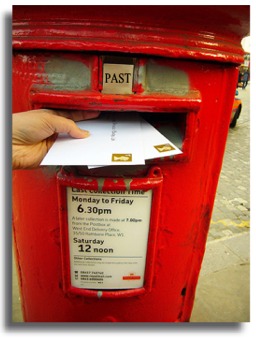Posted by Nicky Drayden on Aug 3, 2010 in
Reviews Published by: Fantasy Magazine, July 19th, 2010
 Photo by Keven Krejci Creative Commons
Photo by Keven Krejci Creative Commons
The Story:
A woman who’s good at losing things runs out of sugar while baking a cake for her sister’s birthday. She’s determined to find some, so she sets off shoeless and with a measuring cup in hand, asking neighbor after neighbor until she comes to the house of an old woman with a giant, bleeding heart in her backyard.
The Craft: 20 Master Plots – The Quest
SPOILERS
I almost skipped over this story, because after reading the first couple paragraphs, I was thinking “how interesting could a story be about a woman who goes on a quest to find a cup of sugar?” Well, the answer is very. Typical of Quest plots, this story starts off with the character at home. She’s forced to venture outside out of the necessity of finishing a birthday cake for her sister — her sister’s first birthday since being dead. So her quest is more than just about the sugar, but it’s an emotional quest to deal with the loss of her sister, as well.
She hits up neighbor after neighbor, but no one seems to have the sugar she’s looking for. Finally, she’s sent to Miss Harriet’s house, an older woman who’s lonely, and stalls while finding the sugar just to have company a little longer. Right as the main character starts to contemplate stealing the sugar bowl sitting so obviously on the counter, Miss Harriet asks her if she’s come for the heart. Out in her backyard sits a giant bleeding heart that fills the sky. The character climbs up and into it, pushing through tight flesh and bloody viscera, searching for the heart’s center. Her quest for sugar quickly is replaced by the physical manifestation of her own broken heart and her need to deal with the loss of her sister.
This story is a very touching one, one with great details, descriptions, and high emotional stakes. Halfway through, I went from leaned back in my chair, to sitting with my nose inches from my screen. (I love when a story makes me do that!) The ending has wonderful imagery of the center of the heart being like a child’s tent, a safe place that reminds the main character of all those times spent with her sister in small, intimate spaces — blanket forts in sunny rooms and reading fashion magazines under the covers with flashlights. We feel her heartache and understand her decisions, and I’m glad I kept reading what started off as a simple quest for sugar.
Tags: Fantasy Mag, literary, master plots
Posted by Nicky Drayden on Aug 1, 2010 in
Reviews Author website: http://swapnawrites.com/
Published by: Fantasy Magazine, July 26th, 2010
 Photo by Rosa y Dani Creative Commons
Photo by Rosa y Dani Creative Commons
The Story:
Twin sisters, the eldest destined to marry the Headman’s son and lead their tribe and the younger resentful of that fact, listen to a story as told by their wise, old Tribemother. In the story, Kushi, a young healer apprentice finds herself caught between the will of her gods, the safety of her tribe, and her own morality.
The Craft: 20 Master Plots – Temptation
MAJOR SPOILERS
So of course my first 20 Master Plots story would have a frame narrative, but both stories are tales of temptation. I loved Younger Sister’s voice, how she kicked over her Elder Sister’s sandcastle without remorse, and then wanders off for awhile since it would take time for her sister to rebuild anything worth kicking again. Younger Sister gladly would have given into her temptation of crippling her sister if it hadn’t been for Tribemother stepping in and telling Kushi’s story. But since the bulk of the story is about Kushi, I’ll analyze her temptation.
Kushi’s temptation comes in the form of gods whispering for her to kill her tribemate Bataar in order to protect her village. This is a tough decision for Kushi to make. People are dying because of Bataar’s ill-will, though Kushi is hard pressed to prove it. Kushi decides that she cannot kill because it would be immoral, even if it will protect Bataar from killing again. Her inaction results in the death of their Headman. Kushi directly accuses Bataar in front of her tribe and puts herself at risk. Her temptation had blinded her to better options for dealing with the situation, and as a result, she becomes exiled from her people.
Both tales are interesting with high stakes and good tension. I found myself wishing there was more to Younger Sister’s story though. Her character was so deliciously wicked that I wanted to experience her temptations directly. I was less engaged with Kushi, though I did like how each sister was given the opportunity to end the story. So who’s story is this? Perhaps this is Kushi’s story, but then again, perhaps not.
Tags: fantasy, Fantasy Mag, feathers, folk tale, gods, master plots, young adult
Posted by Nicky Drayden on Jul 4, 2010 in
Reviews Published by: Analog Science Fiction and Fact, September 2010
 Photo by Sarah G. Creative Commons
Photo by Sarah G. Creative Commons
The Story:
A high school counselor and sometimes basketball coach is tasked each year with consoling the students who don’t receive letters from their future selves on Red Letter Day. She knows first hand the devastating effect of not getting a peek into her future, of not getting the tidbit of advice that will encourage a certain career path, or at the least, warn of a grave mistake to be avoided. She’s spent the last 32 years wondering why her future self hadn’t told her to go straight to pro basketball out of high school, or warned her that she’d blow out her knee in her first college game. She’s the kind of person who’d leave a note for her former self, which leaves her to wonder if she won’t survive to write the note at all.
Her fiftieth birthday is now two weeks away, on which she’ll be able to write her letter to her former self. Time travel laws dictate that there can only be one message that goes back into time, with only one specific event mentioned in the letter. These strict laws insure that major past events aren’t purposefully tampered with, though millions of alternate universes are still created from the contacts, and worse, our futures become something limited by a few words scribbled onto paper.
The Craft:
SPOILERS
Red Letter Day is a great example of putting a human face on the implications of time travel. Politics would play heavily into such an invention, and could easily run amok if not strictly controlled. I really enjoyed the solution of the red letters, which allows everyone to have their hand at time travel, though not directly. This piece was also didn’t leave me with my usual time-travel headache by writing off all of the anomalies as alternate universes spurred off of the original. Seeing how the narrator’s life had been changed by not receiving a letter was touching, and it’s interesting that she fell into a life of counseling others who found themselves in the same situation. She gives a lot of thought to the situation, and even though she’s not angsty about it, we can see how deeply this has affected her, throwing her into a life-long puzzle with no solution.
Though this piece is short, it resonates well beyond the events in the story. A broader technological world exists, hinted at through mentions of interactive technology and nanosurgery. I liked how nonchalantly the science is woven into the fiction, not calling attention to itself, but there. And of course, the story poses the moral implications of time travel, even something so seemingly innocuous as a vaguely worded letter from the future — how it can destroy lives just as easily as it can save them. This story is definitely a fun one to think about, especially with the twist ending. What piece of advice would you send to your eighteen-year-old self, if any? Would it differ if you hadn’t received a note the first time around? 
Tags: Analog, science fiction, time travel
 Photo by Keven Krejci Creative Commons
Photo by Keven Krejci Creative Commons


